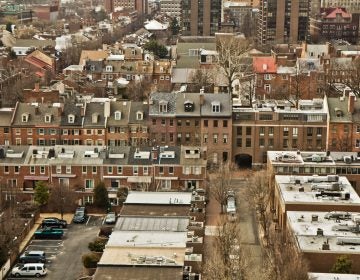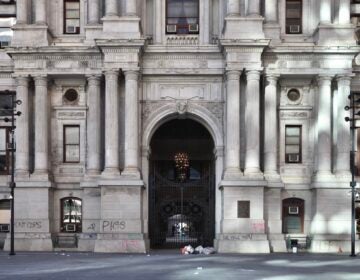DAGspace: Preservation Is Design
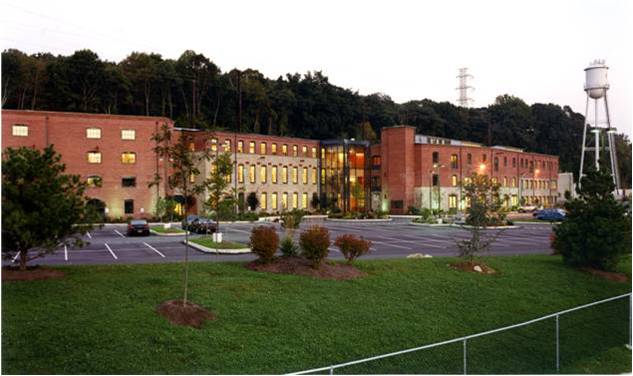

Preservation is Design
by Kathy Dowdell, AIA
I’ve been involved in several discussions lately about preservation and design, and have started to wonder why we talk about preservation and design, as if the two are separate fields of endeavor. Why preservation and design, with the hidden implication that this really means preservation or design? Why aren’t preservation projects viewed as “design” projects with a capital D?
In the world of architects, good design is always one of the main goals. “She’s a good designer” is a compliment of the highest order. “I don’t think that So-and-So Inc. is really a design firm” generally means that a firm’s focus is elsewhere. But what do these statements say about design? How is design defined? In this context, it usually means one has designed a new building, in a modern or contemporary style. As my son said when he was younger, “It looks architect-y.” Renovation or preservation projects are not viewed as design in the same way. Adaptive reuse is sometimes viewed as design, sometimes as preservation, and so it straddles the line. But why should this be? Having worked on a number of preservation, renovation, and adaptive reuse projects, I would say they are all examples of good design.
I had an opportunity recently to give a talk about some of the work that I’ve done over the years. Instead of producing a typical list of projects, I decided to focus on several preservation projects that each represented, to me, a significant professional learning experience and accomplishment. As I started to think about those projects collectively, I realized that what made them stand out is not that they are some of my most beloved preservation projects, but that they are all strong design projects.
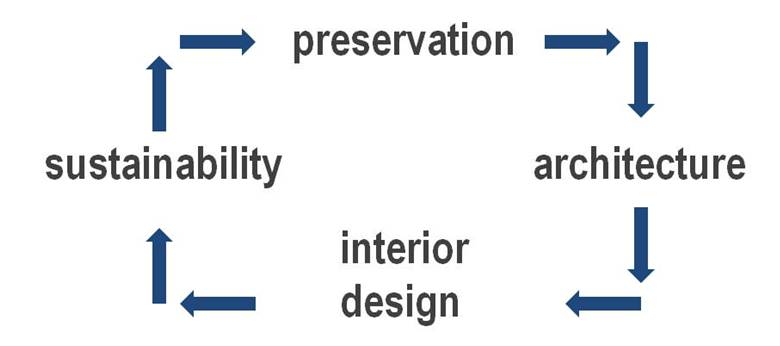
Preservation is design. Preservation is architecture; it is interior design; it is sustainability. All of these elements of our profession are inextricably linked, and all are design. I illustrated this with a diagram.
In a recently published article in the national AIA Historic Resources Committee newsletter, Preservation Education in American Schools of Architecture, Ashley Robbins Wilson, AIA, reports that a number of architecture graduates express great frustration and lament that their programs of study did not include preservation studios. Wilson heard this from recent graduates of architecture schools who were applying to graduate programs in historic preservation:
“All of them wrote in their personal statements about how historic buildings and communities sparked their interests as they embarked to architecture school to learn more. Just four years later, they have concluded architecture licensing is not the road for them as they learned nothing about the history, care or evolution of historic buildings. They saw no path forward to be the type of architects they envisioned – ones that cared for the evolution of an existing place. The very type of architect that we, the readers of this newsletter are – preservation architects.”
Certainly when I went through architecture school, we never had a renovation project as a studio assignment; everything was a new building. Occasionally we had a problem that was a new building with fairly severe constraints – a rowhouse, or a large building on a tight urban site – but we never had an existing building as a starting point, or an adaptive use project, in a design studio. We are not adequately preparing architecture students for the realities of practice in a city like Philadelphia if they have never done a renovation project.
So why are we so reluctant to think of preservation projects as legitimate design projects? And why are we not teaching this kind of design in schools? It seems to stem from a bias in the profession, as if having an existing building made it too easy – gave too much of a head start – and kept one from claiming to have really designed the project. It also reflects a bias that values the development of building elevations (what the building looks like) over strong floor plans (how the building functions and is planned).
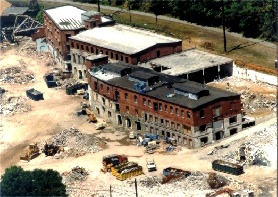
These biases spill over and color our evaluation of the design effort that goes into rehabilitation and adaptive use work; since the building elevations already exist, there must have been very little to design. Or, since it’s only the interior of a building that is changing, it’s interior design, not architecture. But when I look at the projects of which I am most proud, and in which I feel my skills as an architect were best used, they are all preservation, renovation, or adaptive use projects, and the skillful planning and good design is what made the projects successful.
In 1998, our office was commissioned to turn the nineteenth-century Simpson Paper Mill into office space. We demolished a number of later structures on the site, and rehabilitated the three original brick mill buildings. This was my first large-scale preservation/adaptive reuse project, and also my biggest design project to date.
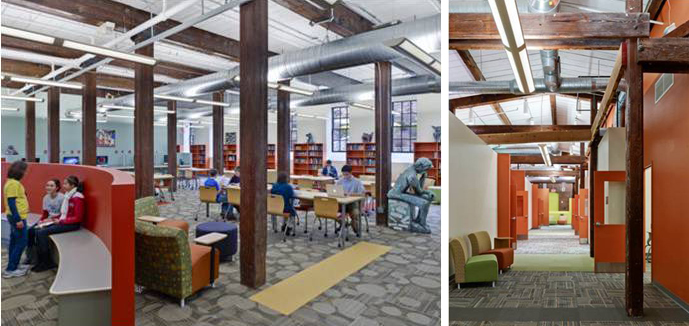
The offices were vacated in early 2010, and the Academy in Manayunk, an independent school, leased most of the space. Happily, we were commissioned to adapt the buildings for their new use. In this project, the interior design became a larger focus, with more character and specificity than the relatively “vanilla” space the previous office users had demanded. But the timbers and trusses of the original buildings had been left exposed in the previous renovation, and they remain so throughout the school.
In these three buildings, we’ve thus had two great design opportunities–two successful re-purposing efforts in a group of buildings long abandoned and slated for demolition, and we have created spaces that will last for years. Preservation is architecture; it is interior design; it is sustainability. Preservation is design. Let’s start thinking about it that way, and let’s start teaching it.
———
Katherine Dowdell, AIA, is a principal with Blackney Hayes Architects in Philadelphia. She has served as chair of the board of directors of the Preservation Alliance for Greater Philadelphia.

DAGspace is a monthly opinion column written by members of the Design Advocacy Group (DAG), with the goal of promoting good design by encouraging thoughtful public discussion of design matters. The mission of the Design Advocacy Group is to provide an independent and informed public voice for design quality in the architecture and physical planning of the Philadelphia region.
The next DAG meeting is this Thursdsay, May 3 at 8am, at the Center for Architecture (1218 Arch Street). Tim McDonald of Onion Flats will discuss Ridge Flats, a new passive-design development on Kelly Drive in East Falls.
In addition to appearing on DAG’s website, you’ll be able to read DAGspace on Eyes on the Street. You can read previous DAGSpace articles here.
WHYY is your source for fact-based, in-depth journalism and information. As a nonprofit organization, we rely on financial support from readers like you. Please give today.





